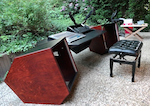Live-Recording
Recording of acoustic instruments during a live performance is quite a challenge, because good microphones are very expensive and significantly alter the luggage, because also tripods, spiders, many long wires and stageboxes with multicores are part of it. Setup and adjustment is real work (and stage floors are dirty) - and with ten microphones you usually also need ten microphone stands (metal, heavy, and one can easily pinch the fingers). For overhead or room recordings you may need microphone boom stands - real beasts (with counterweights). So if you want to record "properly", it's usually a complete job - which requires a very hefty financial investment and technical and musical (basic) knowledge beforehand. Making music at the same time is pretty much out of the question. If you want to do it anyway, even without the "full program", it quickly becomes a balancing act.

Of course, smaller equipment is sufficient for recording your own projects and smaller ensembles. Before each recording of other ensembles or bands, there is an orientation about the style of the music, since it is usually connected with certain recording techniques, then about the recording location (acoustics) and about the number of microphones and audio channels needed (hardware). Are acoustic elements needed? It is fairly often that the microphone used for hall sound reinforcement is not suitable for recording and a second mic is required (and both are recorded). Guitar or bass amps can be recorded via line, but it is better to also place one or two mics in front of the amp (for electric instruments) or at the (acoustic) instrument. Today, drum set miking is done with an average of 7 microphones... So there are a lot of logistics that need to be sorted out in advance before you have to deal (or struggle) with the circumstances on site, usually under time pressure.
If more mics are needed than are available, in most cases it is advisable to prefer renting expensive mics and perhaps first purchasing a few mic stands and wires for somewhat larger projects, in order not to fail with good mics due to bad stands and wires. Instrumentalists and vocalists who play with amplification carry their own mics (and even preamps) more often these days. In many cases, these are very specialized and high-quality solutions. For the musicians, it's the best way to perform stress-free. That way they have "their sound" and they also have an idea of how it should sound.
When it comes to microphones, a lot has happened over the last 20 years. For example, there are now good miniature microphones such as the DPA d:vote 4099, which can be "specialized" for different instruments by using special mounts and even manage the straddle between recording and live amplification. They are also available as a set with different mounts. They open a simple and acceptable solution especially for instruments (e.g. strings) that are difficult to record in ensembles featuring louder instruments on stage.
For my intentions, microphones should be as good as possible in terms of quality, be reliable and, if possible, also small - the only thing that speaks against this is my preference for large-diaphragm microphones. Especially when recording with only a few microphones, they can be an advantage. I do not "produce" music, but record music "live". This also means that "the best" microphones may not be the most suitable. Many recording venues have difficult (poor) acoustics, i.e. lots of sound reflections, a noisy bar (and noisy audience), coffee machines or the like - and I don't want any of that on my recording - but I also don't travel with acoustic elements to prevent that. I don't own a truck, and above all I want to record "as unobtrusively as possible" - or even while I'm playing in the ensemble myself.
These circumstances lead to the fact that sometimes you have to make a trade-off. It is possible that a wireless system and a not so powerful miniature microphone will still make the better recording overall - this might be because of the addressed noise or poor acoustics, or simply because the sound source is moving too much. If the microphones record "too much", there is a danger of feedback in the auditorium and, during the mix at the latest, you will have to deal with (too) much crosstalk.
My Microphones
 The microphones in my collection were acquired gradually over a period of about 40 years, and most of them are no longer in production. I will say a few words here about the most distinctive ones I still own. The first good mics were two Sennheiser MD421s, discarded by NDR, which I bought in 1976 in order to pick up my piano on stage for amplification. Ten years later I purchased my first condenser mics for recording, two AKG C414 B-ULS (at launch), which I still use on virtually every recording. Of all my microphones, they are still the most versatile. I don't like AKG's numerous C414 successor models - I once had an AKG C414 XL II, but I couldn't get comfortable with it. It rather reminded me of the Neumann U87, which I had just previously parted with. It sounded "too bloated" to me. XL II and B-ULS are fundamentally different microphones, and the C414 XL II may have its merits in a studio environment or sound booth (as does the U87). However, it was not well suited for my purposes. With the historic C414 B-ULS it is almost impossible to make bad recordings!
The microphones in my collection were acquired gradually over a period of about 40 years, and most of them are no longer in production. I will say a few words here about the most distinctive ones I still own. The first good mics were two Sennheiser MD421s, discarded by NDR, which I bought in 1976 in order to pick up my piano on stage for amplification. Ten years later I purchased my first condenser mics for recording, two AKG C414 B-ULS (at launch), which I still use on virtually every recording. Of all my microphones, they are still the most versatile. I don't like AKG's numerous C414 successor models - I once had an AKG C414 XL II, but I couldn't get comfortable with it. It rather reminded me of the Neumann U87, which I had just previously parted with. It sounded "too bloated" to me. XL II and B-ULS are fundamentally different microphones, and the C414 XL II may have its merits in a studio environment or sound booth (as does the U87). However, it was not well suited for my purposes. With the historic C414 B-ULS it is almost impossible to make bad recordings!
When I switched from piano to live electronics, I needed to upgrade my microphones. For live sampling and simultaneous stage miking I even had very good experiences with the AKG B-ULS, but I desperately was in need of better dynamic microphones. Thus, two Beyerdynamic TG-X 580s were added, only produced for a short time, really amazingly good, very affordable and versatile microphones, which also showed the best results in a big comparison we made at that time in the electronic studio in Basel.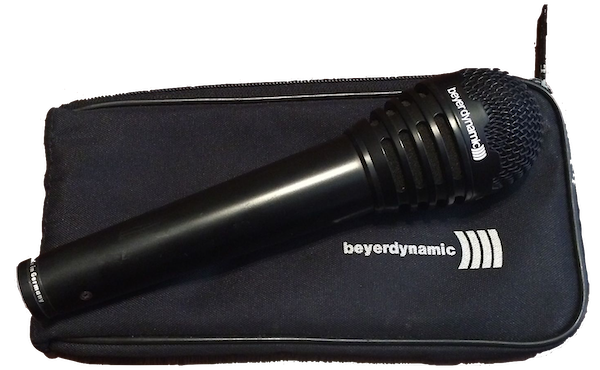 They also were the sole one of the entire TG-X n80 series (180 - 580) that came into question at all. This was because low frequencies are also reproduced very well and the mic only reveals very little proximity effect (when it rumbles when miked close up). Suitable for miking toms (drums) and guitar amps, for sampling (even loud signals) and for many other sources - I just wouldn't recommend it as a "vocal mic" (as which it was advertised).
They also were the sole one of the entire TG-X n80 series (180 - 580) that came into question at all. This was because low frequencies are also reproduced very well and the mic only reveals very little proximity effect (when it rumbles when miked close up). Suitable for miking toms (drums) and guitar amps, for sampling (even loud signals) and for many other sources - I just wouldn't recommend it as a "vocal mic" (as which it was advertised).
I still use the Beyerdynamic TG-X 580 today - and they have proven to be pretty rugged microphones.
 In the mid-90s my intense "electronic guerrilla" period began and I was on the road quite a lot, including by airplane, which meant that the microphones, stands and wires were just too much luggage. By chance I came across the Sony Freedom Series miniature set, which really lived up to its name - also in terms of pricing. Wireless systems were still fairly new in the mid-90s and therefore quite expensive. The set that was offered to me was two transmitters and receivers (pictured), it included another dual 9.5 inch receiver that eliminated even the smallest interference - and it was affordable.
In the mid-90s my intense "electronic guerrilla" period began and I was on the road quite a lot, including by airplane, which meant that the microphones, stands and wires were just too much luggage. By chance I came across the Sony Freedom Series miniature set, which really lived up to its name - also in terms of pricing. Wireless systems were still fairly new in the mid-90s and therefore quite expensive. The set that was offered to me was two transmitters and receivers (pictured), it included another dual 9.5 inch receiver that eliminated even the smallest interference - and it was affordable.
With this Transmitter/Receiver System, I also moved to miniature (lavalier) microphones. The results were amazingly good. The microphones now also didn't need any mic stand and were simply latched into place. My miniature mics are made by Sony and DPA and they have very different specifications for different applications. The gear was now really shrunk down to hand luggage size and set up and disassembly only took minutes! This kind of microphones are also better suitable for the "electronification" of acoustic instruments in very special positions - maybe you don't want a usual instrumental pickup, but you want to amplify special background noises (e.g. the damping mechanism of a grand piano) in order to process them further in the electronics.
Then, in 2005, I was head of the recording studio at the Bird's Eye Jazz Club in Basel for almost a year. A jump into the deep end and the chance of learning everything I needed to know about recording technology in practice. But the conditions were completely different from the electronic studio at the academy. There was no Studer mixing console, but many (very expensive) microphones and mic preamps - as well as very difficult acoustic conditions. A permanent battle against reflections and crosstalk, constantly changing band lineups, sizes, styles, instruments and volumes, and little time to adjust. A good school, but not my future. Leaving the club was also the birth of my idea of the "Mobile Studio".
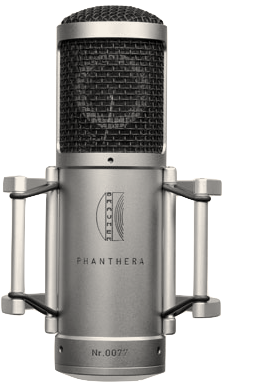 Eventually "good" audio interfaces proved good enough and finally also included good microphone preamps, hence I acquired two Brauner Phanthera for my recordings, quite excellent large-diaphragm condenser microphones that (are supposed to) resemble tube microphones in terms of sound. However, they are rather large, have neither a switchable characteristic nor a switchable filter, and thus are not as versatile as the AKG B-ULS. The later released Phanthera V had been equipped or upgraded with these features. Since I mostly use cardioid and had the AKG B-ULS, I didn't miss anything. I added filters or attenuation, when needed, on the channel strip of my audio interface.
Eventually "good" audio interfaces proved good enough and finally also included good microphone preamps, hence I acquired two Brauner Phanthera for my recordings, quite excellent large-diaphragm condenser microphones that (are supposed to) resemble tube microphones in terms of sound. However, they are rather large, have neither a switchable characteristic nor a switchable filter, and thus are not as versatile as the AKG B-ULS. The later released Phanthera V had been equipped or upgraded with these features. Since I mostly use cardioid and had the AKG B-ULS, I didn't miss anything. I added filters or attenuation, when needed, on the channel strip of my audio interface.
The Phanthera is well suited for very close recordings and "microscopes" very gracefully. However, the special texture that the microphone creates comes into its own more distinctly with a bit more spacing. A velvety sound that also survives some post-processing quite well.
Another four dynamic mics, all classics, joined the set: two Shure SM57, very popular for snare, hihat and amp pickup - but they can do much more, an Electrovoice RE20 (pictured on the cover above right) for loud instruments with a direct sound (e.g. trumpet) - in fact it's very large (with its own mount) and heavy, but it's also very good for voice recordings in unattenuated rooms. For bass drum and percussion instruments, an AKG D112 completed the set of my dynamic microphones.
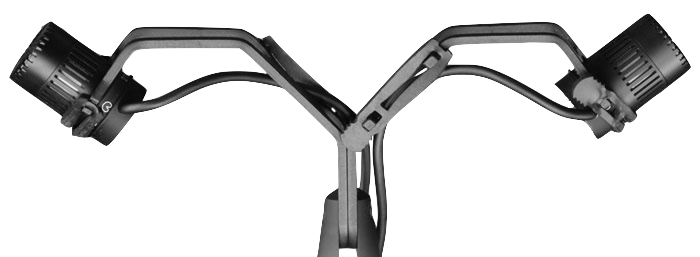 With good luck I managed to buy a second hand "matched" pair of DPA 4021 small diaphragm condenser microphones. I was familiar with the DPA 4011, of which I was very, very fond, from the Bird's Eye Club, and the DPA 4021 shares the same capsule as the 4011. By adding the dual mount, I upgraded it to the DPA 3521. These microphones are simply marvelous! The dual mount makes them perfect as a stereo mic on a piano, especially for "jazz piano" recordings where, unlike classical piano recordings, the mics usually tend to be placed above (behind) the action for a more aggressive sound (and less crosstalk from other instruments). They are ideal for close miking and can withstand very high sound pressure (150dB). Whether piano, strings, or brass, they are also welcome as overhead mics. The first term that comes to mind for this class of DPA mics is: " precision".
With good luck I managed to buy a second hand "matched" pair of DPA 4021 small diaphragm condenser microphones. I was familiar with the DPA 4011, of which I was very, very fond, from the Bird's Eye Club, and the DPA 4021 shares the same capsule as the 4011. By adding the dual mount, I upgraded it to the DPA 3521. These microphones are simply marvelous! The dual mount makes them perfect as a stereo mic on a piano, especially for "jazz piano" recordings where, unlike classical piano recordings, the mics usually tend to be placed above (behind) the action for a more aggressive sound (and less crosstalk from other instruments). They are ideal for close miking and can withstand very high sound pressure (150dB). Whether piano, strings, or brass, they are also welcome as overhead mics. The first term that comes to mind for this class of DPA mics is: " precision".
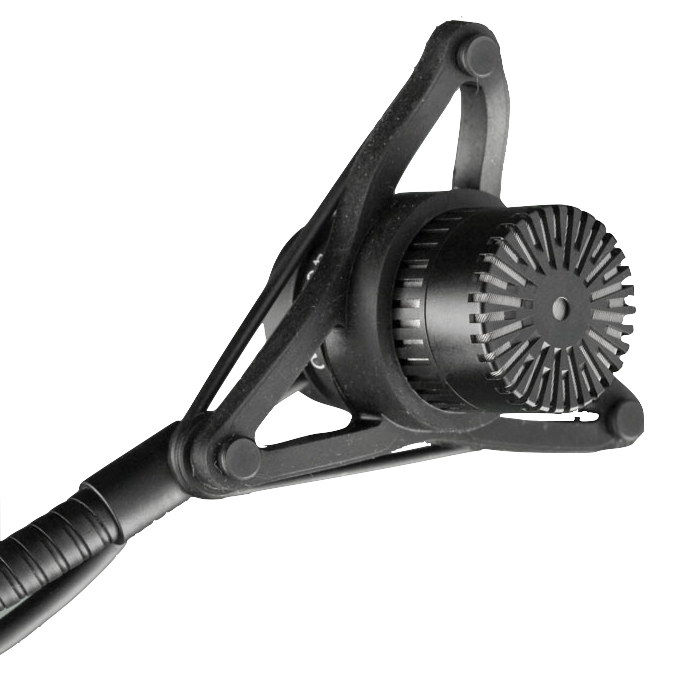 When used with the single 4021 gooseneck mountings, they are a class of their own as mono microphones! Absolute top notch, extremely small and therefore alone highly versatile. The stereo mount allows different orientations of the microphones: besides the ORTF stereo position (picture above), they may be inserted crosswise for an XY recording (good for room recordings). DPA's additional gooseneck and magnetic mounts, e.g. for individual positioning directly on the instruments, make these mics almost general-purpose. I would love to have a second pair of these microphones as well.
When used with the single 4021 gooseneck mountings, they are a class of their own as mono microphones! Absolute top notch, extremely small and therefore alone highly versatile. The stereo mount allows different orientations of the microphones: besides the ORTF stereo position (picture above), they may be inserted crosswise for an XY recording (good for room recordings). DPA's additional gooseneck and magnetic mounts, e.g. for individual positioning directly on the instruments, make these mics almost general-purpose. I would love to have a second pair of these microphones as well.
In the meantime, the 4021 also runs under the designation 4011 and becomes the "former 4021" by the choice of the preamplifier (MMP-ES or MMP-ER). Explanation of terms: "MMP" (preamplifier), "ES" (with cable at the side) and "ER" (with cable at the back).
Previous Approaches
Of course, not everything went purposefully and in a straight line, and a lot of microphones had come in and gone out again. Originally, I had a completely different intention with the studio and the microphones: I wanted to combine modern audio interfaces, which didn't have really good mic preamps at that time, with historic tube microphones and mic preamps - and it was a "pleasureful" affair!
Thanks to a "good connection" during the dissolution of the (state-owned) GDR studios, I came into possession of tube microphones from Microtech-Gefell - the eastern offshoot of the Neumann company. These were so inexpensive that I dare not even mention the price! By means of small labels, I was able to identify them as "the better of the lot" - in those studios, it was common practice to attach small identifiers to microphones and microphone cases to ensure the best possible quality in recordings. I sent the microphones for technical service and, meanwhile, made the battered feeding-unit cases look more appealing. Pictured here is the smallest model, an M582.1 with feed section, after service and refurbishment. Instead of the original mount, however, I mounted them to the stand using a spider. These historic tube microphones are truly a dream!
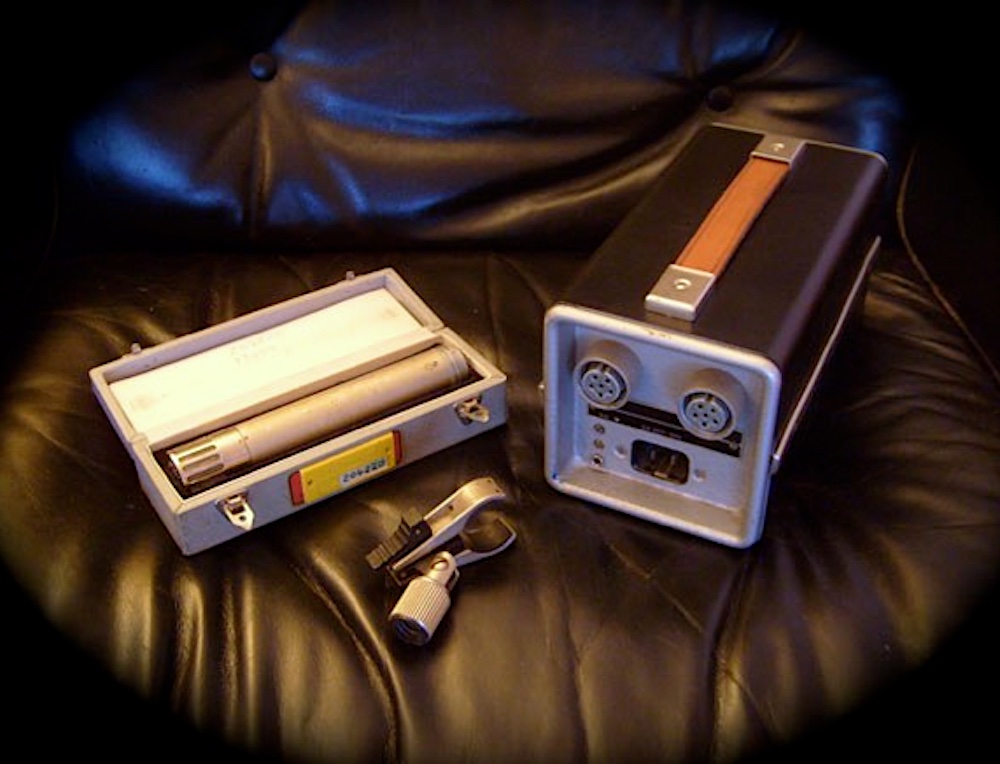
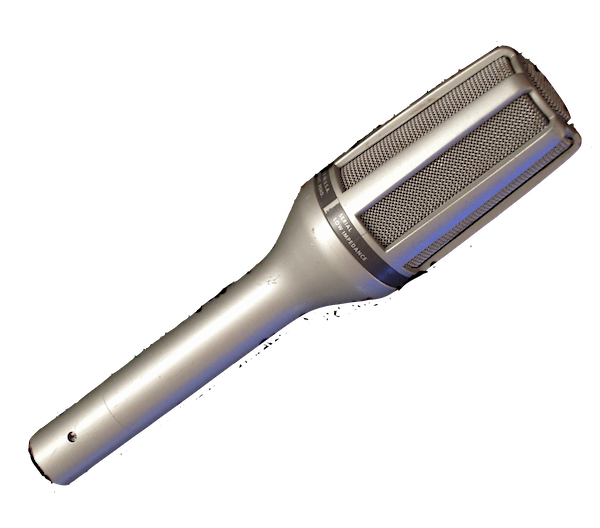 During the 90s I had worked a lot with singers (including with Electric Phoenix/Terry Edwards) and had thus acquired some (dynamic) Shure SM59 "hand mics" - fairly rare mics that I found very pleasing for many voices and ideal for live performances. They are not as loud as SM57 or SM58, but provide a much more refined definition, are fairly straightforward for vocals, and they look very nice and decent as well (singers are grateful for this). Some of the members of Electric Phoenix, when receiving the mics for the performance of Berio's "Sinfonia", showed positive response, too, and recalled (and told me) having used exactly these mics also for the early performances of this composition - then still under the name "New Swingle Singers". That pleased me.
During the 90s I had worked a lot with singers (including with Electric Phoenix/Terry Edwards) and had thus acquired some (dynamic) Shure SM59 "hand mics" - fairly rare mics that I found very pleasing for many voices and ideal for live performances. They are not as loud as SM57 or SM58, but provide a much more refined definition, are fairly straightforward for vocals, and they look very nice and decent as well (singers are grateful for this). Some of the members of Electric Phoenix, when receiving the mics for the performance of Berio's "Sinfonia", showed positive response, too, and recalled (and told me) having used exactly these mics also for the early performances of this composition - then still under the name "New Swingle Singers". That pleased me.
The "weak side" of the SM59 mics was their low output, because you need(ed) a strong mic preamp for that - and at that time, from around +25dB, the appearance of noise was still a major problem. So the right (good) amplification was the actual problem. Nevertheless: the SM59 is due to high inherent noise not well suited for recording - but on stage just fine, as long as it is not Rock music, i.e. it is ideal at moderate volumes and modest amplification.
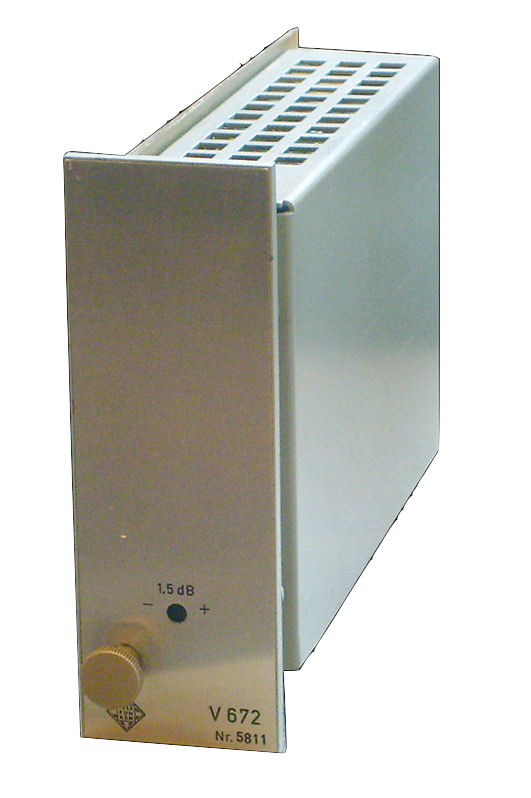 As a preamplifier replacement for the (still) inadequate mic preamps of those audio interfaces, I had intended the historic Telefunken V672 cassettes for all my microphones and bought ( for the beginning) two of them for € 100.- each. These old radio studio amplifiers are still a household item and an excellent sounding solution. It was also convincing to hear this clean preamp in conjunction with a passive summing bus as a make-up amplifier.
As a preamplifier replacement for the (still) inadequate mic preamps of those audio interfaces, I had intended the historic Telefunken V672 cassettes for all my microphones and bought ( for the beginning) two of them for € 100.- each. These old radio studio amplifiers are still a household item and an excellent sounding solution. It was also convincing to hear this clean preamp in conjunction with a passive summing bus as a make-up amplifier.
Telefunken V672 alternatively provide a "vintage" front-end or back-end with up to +70dB gain. The cassette is not just a microphone preamplifier, but has been designed to perform various functions, which has to be selected via the connections on the connector strip. The solid quality of the Telefunken V672 was really surprising for me! Such a discrete built amplifier makes a completely different kind of "body" compared to what we are used to from modern IC designs or even digital amplifiers. However, it can't be said that there is any coloration - the amp is very clean and sounds full. Finally, the Telefunken V672 was developed in 1958 at the NWDR in Bremen to be used in the radio studio. My Telefunken cassettes are from the year 1970.
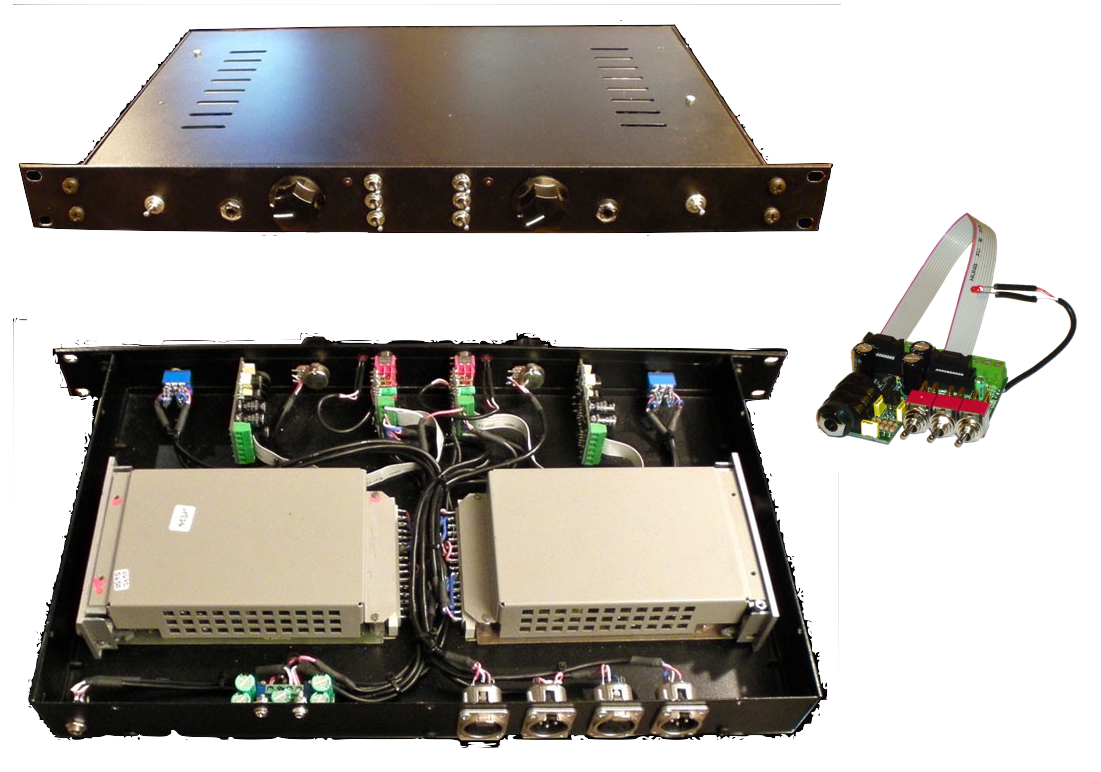 Getting the V672 to work in today's everyday environment, I fitted both cassettes into a 1U 19 inch enclosure and ordered kits from JLM in Australia in order to put phantom power, phase, pad switching and DI inputs on the front and IOs and mains on the rear.
Getting the V672 to work in today's everyday environment, I fitted both cassettes into a 1U 19 inch enclosure and ordered kits from JLM in Australia in order to put phantom power, phase, pad switching and DI inputs on the front and IOs and mains on the rear.
Although everything turned out excellently, doubts arose after a short calculation - not financially, but in kg and m3. The eight channels in the 8 U case would have weighed considerably more than 40 kg and eight microphones with their own supply units and many wires would also have been a big case. In addition, it would also have meant a lot of work during assembly and disassembly.
It was at this time that Metric Halo released the ULN-8 audio interface with eight excellent mic preamps - in one height unit! That was the end for my endeavor. I am still very happy about this decision, but of course also very sad about the loss of the microphones, which I had to sell again (to refinance).
More about the Telefunken V672, which I still enjoy using, but primarily in the studio, is here: Studio Hardware & Setup
Primary Source Enhancer
 The Portico 5045, secret weapon of Rupert Neve Designs is a feedback killer and is capable of boosting two microphone signals by up to 20dB before feedback occurs, without negatively affecting the source signal. This processor "senses" when signals are coming into the microphone and allows the signal to pass, or lowers the volume if the signal goes silent. It is remarkable that the 5045 entirely lacks filters and/or digital technology for this task. Included, however, are Rupert Neve's excellent transformers, which reproduce the signal (and probably also provide for an amazingly high weight despite small dimensions).
The Portico 5045, secret weapon of Rupert Neve Designs is a feedback killer and is capable of boosting two microphone signals by up to 20dB before feedback occurs, without negatively affecting the source signal. This processor "senses" when signals are coming into the microphone and allows the signal to pass, or lowers the volume if the signal goes silent. It is remarkable that the 5045 entirely lacks filters and/or digital technology for this task. Included, however, are Rupert Neve's excellent transformers, which reproduce the signal (and probably also provide for an amazingly high weight despite small dimensions).
In live electronics there are so many unwanted encounters with feedback that the RND 5045 is a ace on your sleeve. This processor is also helpful, for instance, in church acoustics or stage amplification with condenser mics. In fact, the sound is almost refined by the transformers. Feedback problems are a thing from the past with Portico 5045.
PA
I'm not a fan of industrial "sound reinforcement". Even the usual (cinema-like) stage situation, possibly with monitor floor speakers on stage (that yell at you), is not my cup of tea. Hence, the next thing that came to my mind was the purchase of a PA, in order to be able to work really autonomously. From the Basel Music Academy studio, I knew the NEXO PS-10, with which we had achieved excellent sound reproduction even "open air", in the Jura mountains. At that time, it was the only PA that could compete with the big, much more expensive brands. Yet NEXO had released the PS-8, and sonically I even preferred the sound of it. Already before I heard it, it showed another advantage: the subwoofer was now no longer as big and it is easy for one person to carry. A decisive factor for transport. In fact, the subwoofers are so small that I always have the second PA with me (just in case), even for 2-channel applications - perfectly suitable for car trunks. The NEXO power amplifiers depicted - with integrated controller - are no longer manufactured. The subsequent PS PAs consisted of two 19' units, controller and amplifier, and they were a bit bigger, heavier and more expensive. I am very happy to own these amplifiers!
 NEXO PS-8 - these small PAs are a real blast! Their performance (dispersion) and sound characteristics are in no way inferior to the very big names in this industry - such as MeyerSound or D+B. With these truly small PS-8 NEXO had managed to make a big deal!
NEXO PS-8 - these small PAs are a real blast! Their performance (dispersion) and sound characteristics are in no way inferior to the very big names in this industry - such as MeyerSound or D+B. With these truly small PS-8 NEXO had managed to make a big deal!
The PS-8 delivers clear treble and can deliver a stable, musical and balanced sound! The subwoofer can be heard quite fast and early enough - this was a weak point of the PS-10. The PS-8 is also excellent with "instrumentally amplified" live electronics in the chamber music ensemble. Despite its small size, it delivers an incredible 1750 watts - and more importantly, even from the 12th row, all sonic details are audible and intact! Usually this is exactly where many sound reinforcement systems fail - especially in this size range. Because I also do 4-channel performances, I immediately purchased a second PS-8 PA after a short test. For extra "fat" 2-channel performances, the PAs can also run in parallel and then double the power to 3500W!
These PAs really gave me autonomy and also benefits for recording. Not only do they sound better, they are also not permanently installed (for an altogether different sound reinforcement "philosophy"). Anything can be arranged by me now to suit the piece/music, the venue and the recording best. You can't guess the power of these little PAs just by seeing them. You need to listen to them - and you won't believe everything you hear is solely coming out of that small PA! On several occasions, promoters or musicians said with mild horror at the beginning, while setting up the PA, "I thought you were coming with a PA!?" - After the concert, all of them seemed to have been exchanged and were excited about the particularly good sound that evening.
Since the cooperation with Yamaha, NEXO has changed a lot. Meanwhile, the PS series has become the P series. I can't say anything about the current models, but here is the link:
Audio samples
Hayden Chisholm at the Sendesaal Bremen
"The Well Tempered Shruti-Box" was the title for this evening in the series "Concerts in the Dark", which took place at the Sendesaal Bremen in 2012. The Sendesaal is one of the best-sounding historic studios in the world, has a great history and a perfect reverberation time of 1.42 seconds!
The recording was done with 6 microphones. For the close-up a DPA 3521 (2x 4021 + stereo mount), small-diaphragm microphones that show an incredible accuracy of the details. At about 1.5 meters distance I used the very smooth and "silky" Brauner Phanthera and at about 5m distance and 3m height the AKG BULS (omnidirectional setting) for the room.
Hayden Chisholm - alto saxophone and shruti-box
Here is another clip from that evening. It is a rough mix of the original unedited 192 kHz recording. This concert has since been released on record - being part of a large compilation (13 CD's) of the New Zealand saxophonist.
A room that sounds as good as the Sendesaal is unfortunately a scarcity and therefore a very special experience - both to play and to record in.
As a counterpart to the extremely good sounding Sendesaal, here are two jazz band recordings - a quite different music in a completely different acoustic environment. The "Bird's Eye" jazz club is a rather difficult recording location - it's in a small, former prison gymnasium in Basel/CH. A real challenge. The recording studio was right behind the stage and the recording equipment consisted of processors from Apogee, GML, UA, RME and Soundcraft. The microphones used were from AKG, DPA, Neumann and Schoeps.
Fisch im Trio - at the Bird's Eye Jazz Club in Basel
Donat Fisch - saxophone, Baenz Oester - bass, Norbert Pfammatter - drums
Usually, such recordings are rather "microscopic" in order to remove the room entirely in the subsequent processing. But I wanted to capture the "club sound" and the atmosphere. Here it doesn't go without crosstalk simply because of the narrow stage, and the throwbacks from the wall-ceiling curvature are also audible. I think wildness and atmosphere go well together with the music - after all, it's not a Hollywood movie.
Of the extensive recordings (4 days) of the Trio around the the saxophonist Donat Fisch, one CD has already been compiled and released in 2007 on the Swiss label "Unit Records". I hope that another CD, or better yet, double CD will follow, because this trio really has a lot to offer from a musical perspective!
Walter Jauslin Trio at the Bird's Eye Jazz Club in Basel
Walter Jauslin - piano, Fernado Fontanilles - bass, Michael Wipf - drums.
Same club, but a different sound. However, the recording took place during the day and without an audience (the audience is actually an important acoustic element here, because the "buzzing frequencies" are well absorbed as a result). Walter's trio is more 1950s in style, and I tried to capture the sound that way, too. Jauslin = TimeWarp! - and a very interesting personality with a sharp mind as well! Sadly without an own website.
An Anecdote and a Lesson on Miking
This happened in 1995 at a concert of the Experimental Studio of the SWF: Rudi Strauss - he might be known to some as a collaborator on Luigi Nono's electronic work - in Nono's scores it says here and there " Ask Rudi" or "Rudi has the values" - so, this Rudi was attaching some microphones to the wires hanging down from the ceiling for a concert with string trio and live electronics. Upon getting closer, I noticed that these were Shure SM57 microphones: dynamic microphones - often used in rock music for snare or amplifier pickup. Good, but simple and very inexpensive microphones, which I had never expected in the well-equipped environment of the Südwestfunk in connection with string instruments.
It was about a gentle amplification of the string trio for a better balance to the electronic part. Rudi explained to me that the supposedly bad SM57s are ideal for string instruments because they pick up exactly the amount needed for unobtrusive amplification and do not produce any harshness in that process. Moreover, as dynamic microphones, they are designed to have only a short "listening distance" and thus are not prone to feedback or picking up "extraneous" sounds. And indeed: the trio was heard much more clearly and it still sounded like it was unamplified. It was just the "body" of the entire trio that had been enlarged - not the instruments. I was impressed.
This situation pointed out to me that performance limitations in microphones do not mean poorer quality - this is where the weaknesses of the mic become strengths in coping with the acoustic demands. Bernard Parmeggiani reportedly made some of his signature sounds while walking with a microphone in his bag. This saves a lot of post-processing!





